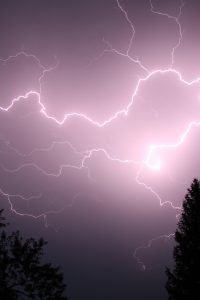How we can extinguish power cuts caused by extreme weather

Record temperatures in Europe over the last year have had a much greater effect than leaving us blistering, says Frederic Godemel, EVP, power systems and services, Schneider Electric.
Our power infrastructures have been placed under significant stress, leaving them worn out for when we needed them most this winter. The current grid was initially built to withstand a climate that no longer exists. An increase in extreme temperatures, high storm winds, flooding, and other events increasingly damage power lines and grid equipment.
Globally, power grids are therefore struggling to maintain peak performance and, as a result, countries are finding manual workarounds: in countries such as India, car batteries are being used to power smaller appliances such as fridges and televisions and, in the UK, the National Grid has advised people to install a battery back-up for essential medical equipment and machineries such as stair lifts, bath hoists, and adjustable beds.
Extreme weather events are only predicted to become more frequent as we experience the powerful effects of climate change. If nothing is done to protect power grids and upgrade their resilience, we can expect greater damage, resulting in more blackouts and power shortages. As our world changes in the face of global warming, an increasing multitude of extreme weather patterns now affects regions that historically did not face such natural events. In countries such as United Kingdom, summer heatwave was the costliest weather disaster which ravaged the UK and Europe racked up $20 billion (€18.30 billion) in losses.
Furthermore, Traditional electricity distribution relies on networks connected by a number of nodes, overhead lines or underground cables. If one of those fails, the electricity cannot be transmitted that is, unless it is directed towards another appropriate route. When this assignment of a new route is done manually, it lacks efficiency. When multiple elements are broken or lost due to powerful, localised extreme weather events, the rerouting process is complex and time-consuming.

This places an economic and social strain on larger and larger swathes of the global population. The increase in natural disasters and severe weather seen globally demands a global change in how we distribute our power to increase resilience and limit the impact on communities.
To tackle this issue head on, nations need to stop merely patching up grids when they fail, and instead invest in systematic change to increase the resilience of nodes, overhead lines and power cables in grids. It is also essential for power systems worldwide continue to be updated to benefit from systemic resilience in the event of loss of centralised power due to weather events.
With these improvements, Grids of the Future can withstand anything from flooding to wildfires. Let’s look at how that’s possible.
How smart grids can mitigate the effects of extreme weather
Grid modernisation is seeing changes that could make grids far more resilient to extreme weather. This means the technology in the grid can predict the location of outage or adversely affected equipment, reroute the electricity, and mobilise repair resources.
This is achieved through smarter, digital grids, that can start the response by engaging their outage management system (OMS) modules these can be part of an advanced distribution management system (ADMS). By predicting where an impact like a wildfire might hit, utilities can pre-emptively instruct the system to reconfigure to avoid an outage for customers, for instance by temporarily islanding a microgrid while engineers work to fix the damage.
Even when planning is not possible, utilities can rely on technology by using automatic network reconfiguration to reroute power. Many will leverage an optimised architecture based on Smart, digital medium voltage electrical equipment.
In short, grid operators can rely on higher-fidelity data availability, siloed data consolidation into integrated databases, and artificial intelligence (AI)-based applications for their decision-making. In essence, sensors and software produce data that enables well-judged, predictive, instantaneous, and automatic choices to protect citizens, businesses, and operations in moments of grid failure.
Say high winds bring down a tap. A smart grid pinpoints the closest suitable opportunity for a power diversion and automatically tells the network to use this route. Or it could suggest activating other networks and microgrids, such as those connected to local distributed energy resources, which could tide communities over until the grid is restored.
In a wildfire, while outage management reroutes the power supply, a fire management module can use geo-awareness to detect affected equipment, minimising impact due to time saved and reducing potentially dangerous work for engineers.
Or perhaps a set of junctions have been flooded by stormwater. The outage management module predicts the damage and reroutes power while the grid is fixed. A digital twin for the network can identify what’s happened and why – reducing the time spent in diagnosis from hours to minutes. While engineers fix the lost nodes, customers aren’t left in the lurch.
How connected data improve climate resilience?
Beyond providing resilience, incorporating, and transitioning to smarter grids based on data is crucial to the global shift toward a greener future. Connected data and virtual models play a vital role to enhance energy reliability.
Improvements in infrastructure planning are needed to enhance climate resilience and minimise disruption to essential public services during extreme weather.
In a natural disaster or extreme weather event, critical services such as hospitals, emergency departments, and social infrastructure being cut off from power can have disastrous effects. For instance, weather-related outages are estimated to have cost the US economy an average of $18 billion (€16.47 billion) to $33 billion (€30.19 billion) annually, adjusted for inflation.
Digital twins can help improve the climate resilience of cities by simulating climate change scenarios, and help cities better anticipate and manage the risks of climate change to enhance climate resilience. In a hospital, this could keep life support machines on the most reliable source of power possible. In care homes, this could keep vital heating units running. In schools, children can continue learning without disruption, whatever storm rages outside.
By leveraging the full potential of digital technologies, power grids can be incrementally improved with sustainable materials and approaches while costly disruption is reduced.
How can we build a more resilient electric grid for the future?
Resilience is key for utilities to reduce and avoid disruption during and subsequent extreme weather conditions. One efficient way to build a more resilient electric grid for the future is to invest in microgrid technology.

Frederic Godemel
Microgrids are self-contained power grids that generate their electricity on-site and are available when they are most needed. To do this, microgrids connect, monitor, and control a facility’s distributed energy resources (DER) while improving performance, sustainable footprint, and resilience.
Microgrids can help utilise more zero-emission energy sources and reduce energy losses through transmission lines, manage power supply and demand, and improve network resilience against extreme weather conditions. For power generation, microgrids typically use a combination of traditional backup generators and renewable energy such as solar panels. Microgrids integrate battery systems to store electricity that can be used during grid failures or peak loads.
The Grids of the Future will be greener, more sustainable, and more digital which will enable the resilience and sustainability required to serve communities reliably and meet their modern electricity needs.
The author is Frederic Godemel, EVP, power systems and services, Schneider Electric.
Comment on this article below or via Twitter @IoTGN
